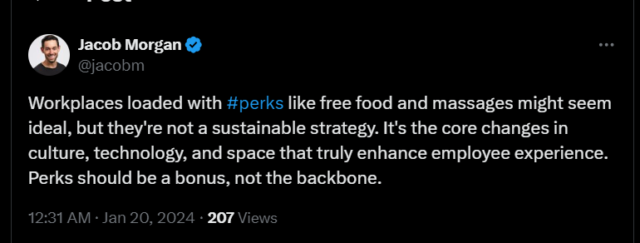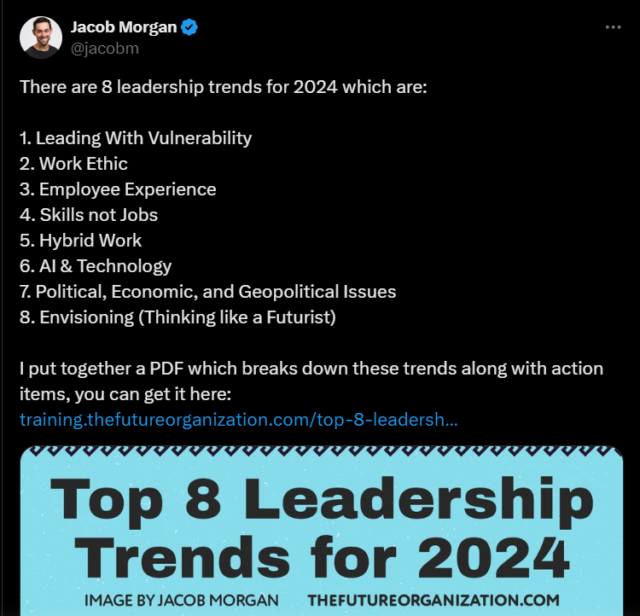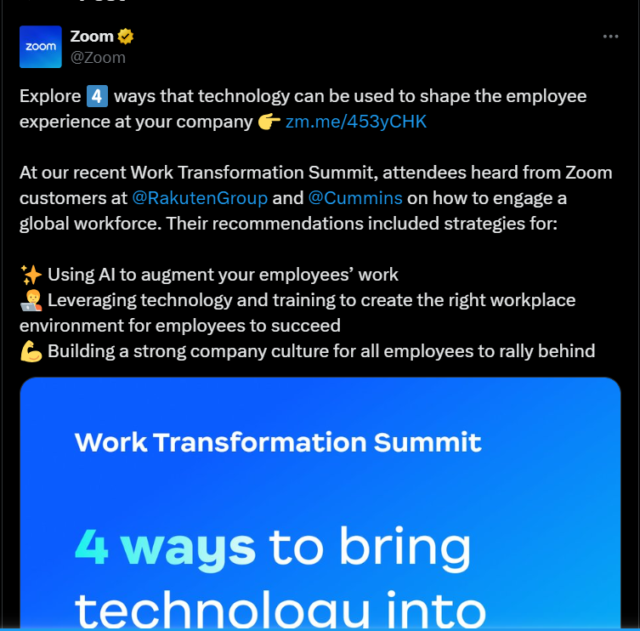Employee experience (EX) has ascended to the top of the C-suite agenda. 94% of CEOs are totally on board with the idea that making work better for employees means bottom-line success. But a significant gap remains: 59% of the global workforce isn’t engaged, and a scary 18% are seriously disengaged.
There’s hope in the form of tech upgrades, offering innovative solutions to transform the employee experience. This blog explores the key technology upgrades that can seriously level up your EX), making the workplace engaging, productive, and just a better place to be.
Understanding Technology Upgrades that Improve EX

X.com
A technology upgrade in the workplace involves implementing new or improved tools, systems, or software to boost productivity, efficiency, and the work environment. Whether it’s upgrading hardware, getting the latest software, or introducing collaborative platforms, the goal is to create a better work environment.
When you invest in these upgrades, you’re not just sprucing up your tech; you’re also creating a more engaged and productive workforce, essential for organizational success.
Benefits of Technology Upgrades
Using technology to make work life better boosts morale, makes tasks easier, and improves communication. That means people are happier with their jobs and stick around longer. Here’s how:
Increased Productivity
Imagine this: AI is set to turbocharge productivity by 40% by 2035, says PWC! Indeed, modern tools and systems streamline tasks and processes, significantly boosting productivity. For example:
- Repetitive tasks eat up so much of employees’ time at work. Well, automation software handles them, freeing employees to focus on more strategic work.
- When employees feel the to-do list is long and time is running out, project management tools help with efficient workflow management. They ensure everything gets done on schedule and within budget.
- Cloud-based platforms enable easy access to documents and collaboration from anywhere, reducing downtime and enhancing efficiency.
Enhanced Employee Engagement
Interactive and user-friendly technology improves employee engagement. With platforms that give instant feedback, add fun game-like elements, and include social features, work becomes way more fun! Plus, these tools create a sense of belonging and community, making it easier for your team to chat, share ideas, and work together.
Better Work-Life Balance
Picture this: your team using video calls, cloud storage, and remote access tools to clock in from wherever, whenever. Amazing, right? This setup goes beyond convenience—it improves work-life balance. With these tools, your team can juggle work and personal responsibilities more smoothly, dialing down stress and dialing up job satisfaction.
Attraction and Retention of Talent
Do you know what gets prospective employees excited about joining your team? It’s when they see you investing in modern, efficient tools. It shows them you’re not stuck in the past but embrace the future to create a supportive work vibe. Furthermore, your current employees are way more likely to stick around when they see you prioritizing their needs and giving them tools that make their work life easier and more enjoyable.
Adaptation of Global Recruitment to Technology Changes

The recruitment game is changing faster than ever, all thanks to tech! AI is making lives easier, remote hiring is becoming the new norm, and there has been an emphasis on tech skills. These shifts are totally flipping the script on how you can get and keep the best talent out there.
Evolution of Recruitment Practices
With the rise of AI and machine learning, the recruitment scene is evolving big time. Did you know that about 44% of companies are bringing AI into their hiring process? Well, it’s a game-changer. These technologies enhance the efficiency and accuracy of hiring processes by:
- Automating resume screening
- Analyzing candidate data
- Predicting job fit
If you’ve ever wished you could find the perfect candidate in a flash, AI-driven algorithms can do so. They can sift through resumes quickly, saving you time and money in the hiring process. On top of that, machine learning also helps eliminate biases. It focuses solely on objective criteria, which means a fairer shot for every applicant.
Remote Hiring Trends
Remote hiring has become increasingly prevalent, thanks to the rise of remote and flexible work opportunities. Would you believe it? About 16% of companies are going full-on remote! And get this: a whopping 98% of workers want to dive into remote work, at least part of the time.
With technology on your side, you can source talent globally, breaking geographical barriers. Video interviews, virtual assessment tools, and online collaboration platforms ease seamless remote recruitment processes.
When remote work is offered, you’re not just pulling from the local talent pool anymore. Being able to work remotely is a total deal-breaker for many candidates nowadays, so it is a key component of contemporary recruitment strategies.
Emphasis on Technology Proficiency
With the rise of tech in every corner of work lives, organizations need a tech-savvy workforce. That’s why when they scout for new team members, they look for those who can ace digital tools. These days, job interviews aren’t just about typical Q&A; they throw in some tech tests to see how savvy candidates are. After all, candidates with strong technology proficiency are better equipped to adapt to dynamic work environments and drive innovation.
Major Elements of Technology Upgrades
Flexible working, consumer-grade tech, and video communication are essential for making your employees happy, boosting productivity, and keeping your workplace running like a well-oiled machine.
Flexible Working
Did you know that 55% of individuals consider remote work the most crucial aspect of their job? And what’s driving this preference? Flexible schedules! Luckily, with the right tech, like remote work platforms and scheduling apps, you can make sure everyone’s happy and productive. For example:
- Cloud-based software, virtual private networks (VPNs), and project management platforms like Asana and Trello allow employees to access work materials and collaborate from anywhere.
- Video conferencing tools like Zoom and Microsoft Teams help with real-time communication, bridging the gap between remote team members.
Flexible work arrangements have a big impact on employees. When people have flexible working conditions, they tend to be happier with their jobs, feel less stressed, and be more productive. This helps them better juggle their personal and work lives.
Consumer-Grade Technology
Using consumer-grade technology in the workplace means using a bunch of tools for different tasks, just like you’re used to in your personal lives. Bringing in tools like Google Workspace, Slack, and Dropbox can make work smoother and more engaging, boosting efficiency.
While these tools are user-friendly and widely adopted, however, integrating multiple solutions can lead to compatibility issues, data silos, and increased management complexity. You should find a balance to make sure everything integrates smoothly, and you get the most out of consumer-grade technology.
Video Communication and Collaboration

Tools like Zoom, Microsoft Teams, and Google Meet make face-to-face communication easy, helping build stronger relationships and clearer communication. Plus, immersive experiences like virtual reality (VR) and augmented reality (AR) can take teamwork to the next level by creating interactive and engaging virtual environments.
For example, tools like Spatial and Oculus for Business give you immersive meeting spaces that can really boost teamwork and spark creativity. These technologies make it easier to communicate and keep the team connected and productive, no matter where everyone is physically located.
Three Technology Upgrades to Improve Employee Experience
To make work life better for employees, a few key tech upgrades really stand out: better collaboration tools, AI personal assistants, and flexible work platforms.
1. Advanced Collaboration Tools
Advanced collaboration tools make it super easy for teams to communicate and work together, no matter where they are. Examples of these tools include Microsoft Teams and Slack:
- Microsoft Teams offers a feature-rich platform for video conferencing, file sharing, and integration with other Microsoft Office applications. This makes it a comprehensive solution for team collaboration.
- Slack has an intuitive messaging system with channels for organized communication and integration with many third-party apps, improving workflow efficiency.
These tools allow real-time communication and collaboration, breaking down the barriers posed by physical distances. Here’s how:
- Features like instant messaging, video calls, and collaborative document editing allow team members to work together effectively, regardless of their location.
- The ability to create dedicated channels for specific projects or teams helps maintain organized and focused communication. This decreases the chaos of email threads and improves productivity.
2. AI-Powered Personal Assistants
AI-powered personal assistants, such as AI chatbots and virtual assistants, are totally changing how employees handle their tasks and workflow. Examples of these tools include IBM Watson Assistant and Google Assistant. These assistants use AI to automate routine tasks, give quick answers to questions, and help with setting up plans and reminders.
AI personal assistants take care of all those repetitive tasks so that you can put your brainpower into more strategic and creative work. Think less paperwork and more brainstorming sessions. Here’s how these tools impact workflow automation and employee productivity:
- AI chatbots can manage customer inquiries, process orders, and provide technical support, which means less stress for employees.
- Virtual assistants can schedule meetings, set reminders, and manage emails. They basically make an employee’s day run smoother.
- AI assistants can provide personalized support, learning from individual preferences and behaviours so they can give you super customized help whenever you need it.
3. Flexible Work Platforms
Flexible work platforms, including cloud-based solutions and remote access tools, support flexible and remote working arrangements. Examples of these platforms include Google Workspace and VPN (Virtual Private Network) services:
- Google Workspace offers a suite of cloud-based applications for email, document creation, storage, and collaboration, all accessible from any device with an internet connection.
- VPN services provide secure remote access to a company’s network, ensuring that employees can safely work from any location.
Here’s how flexible work platforms impact EX:
- Employees love being able to customize their work hours to suit their lifestyles. With flexible work arrangements, they can work from wherever and whenever leading to higher employee satisfaction and retention.
- Secure remote access tools ensure that all the important information your company has stays safe and sound, so you can work from wherever without stressing about security.
- Flexible work platforms are awesome because they let team members collaborate in real-time, even if they’re not in the same office.
Human-Driven Approach in a Tech-Driven World
In today’s fast-moving tech arena, you must try to keep things human. You should figure out ways to mix AI with a good old human touch so your employees can still feel and connect in digital spaces.
Balance AI and Human Interaction
AI and chatbots automate routine tasks. They give speedy responses to the usual questions and make everything run smoother. They’re like your personal assistant, always there to help, day or night. But nothing beats personalized interactions. When you’re talking to a person, you feel heard and understood. They get you in a way AI just can’t. Plus, humans can read between the lines and handle tricky situations with care and understanding.
Enhancing Emotional Connection
Humanizing digital interactions maintains strong emotional connections within teams. Strategies include:
- Video calls instead of emails for more personal communication
- Regular virtual team-building activities
- Informal conversations through messaging platforms.
Emojis, GIFs, and personalized messages can also add a personal touch to digital communication, making it feel more relatable and engaging.
Personalization and Empathy
Customizing tech tools for each team member helps create a more supportive work atmosphere and gets everyone working more efficiently. Whether tweaking user interfaces or using adaptable learning systems, personalized setups allow you to cater to everyone’s unique preferences and ways of working.
When we talk about empathy in tech design, we think about what employees go through and what they actually need. You want to make sure the tools they use are easy to use and don’t make their lives harder. This makes tech feel like it’s on their side, not just something getting in their way. And when you nail that, you’re creating an environment where employees feel valued and supported.
Conclusion
Enhancing the employee experience is essential for organizational success. Advanced collaboration tools like Microsoft Teams and Slack improve communication and engagement.
AI-powered personal assistants such as IBM Watson Assistant and Google Assistant automate routine tasks, increasing productivity. Flexible work platforms, including Google Workspace and VPN services, enable remote work and improve work-life balance.
When you invest in these tech upgrades, you’re not just making work fun; you’re also making your team happier, more pumped, and way more productive, driving overall business success.


